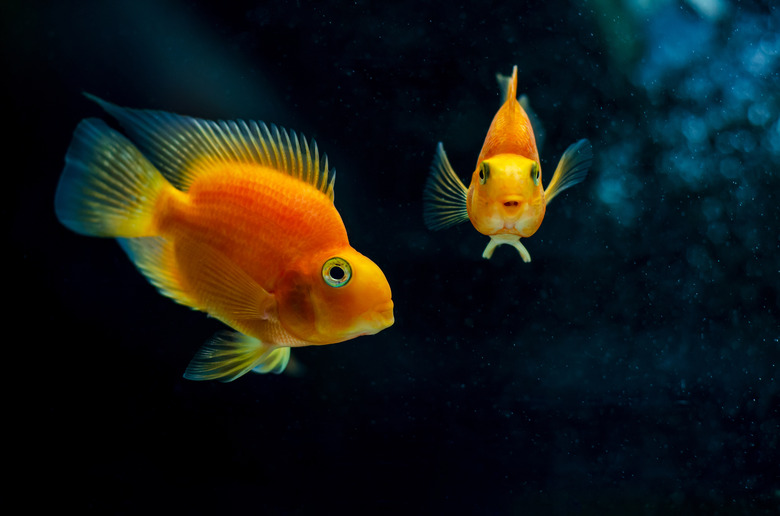How Do I Tell The Difference In A Male And Female Blood Parrot Fish?
The striking beauty of the blood parrot fish might have you heading to your local aquarist to pick up a breeding pair to produce fry of your own — but be warned. This hybrid cichlid is only able to successfully produce fertile eggs when the female blood parrot cichlid is paired with a fertile male cichlid of another species.
Why gender matters
Why gender matters
Even if you successfully mate a blood parrot fish cichlid with a fertile male, the offspring won't look like the parent blood parrot fish. They'll likely be much paler or even a different color depending on the male parent. The pet store cichlids are often produced using hormones, and many are dyed to give them their vibrant hue.
However, knowing the gender of your blood parrot cichlids is useful in preventing tank aggression. When you buy young cichlids at the fish store, it will be impossible to tell them apart. Once they reach about 18 months old and they are sexually mature, you might find that you have several males fighting over a lone female. Selling or trading the aggressors to create a peaceful couple can reduce stress in the tank and keep your fish healthy.
Look at fin shape
Look at fin shape
It's easiest to determine fin shape based on whether the anal and dorsal fins are pointy or rounded. However, in this hybrid cichlid species with its many possible different physical characteristics, this is not 100 percent reliable. Like most fish, male blood parrot fish have longer, pointier fins.
The female blood parrot cichlid typically has rounder and shorter fins. However, this is not always the case, as some females have been known to have angular fins. If you're looking at a fish with round fins, you're looking at a female, but a pointy-finned fish is not always male.
Check out behavior
Check out behavior
When sexually mature, male and female parrot fish begin behaving in ways that will tip you off to their gender. Males will start vying to be the dominant one in the tank if they have not already determined a hierarchy while growing up together. If you have one blood parrot fish herding others around, that's definitely a male.
Males will also spend a lot of time digging in the substrate and moving small pebbles around. This is nest-building behavior, and when spawning conditions are right, he'll lure his mate to the nest for spawning. He'll turn a brighter color and most times will develop pink coloration around his gills and ears.
The females, on the other hand, are more demure and tend to follow the dominant male as if seeking protection. When a male successfully attracts her to spawn, she'll lay eggs in his nest so he can swim over them and spray his milt to try to fertilize them. As male blood parrot cichlids usually aren't successful, the eggs will turn white in a few days, and the parents and other fish will eat them.
Male and female parrot fish
Male and female parrot fish
Once fish are sexually mature at about 18 months old, you may be able to tell which is male or female through physical attributes. Male blood parrot fish tend to have more definition between their face and their arched back. Females tend to be more rounded with a smoother transition from their face to their back. They also tend to be smaller than the males.
An examination of the vents on their underside can also reveal gender. Once a female starts laying eggs, the anal cone will appear pear-shaped as the vent used for passing eggs becomes enlarged.
